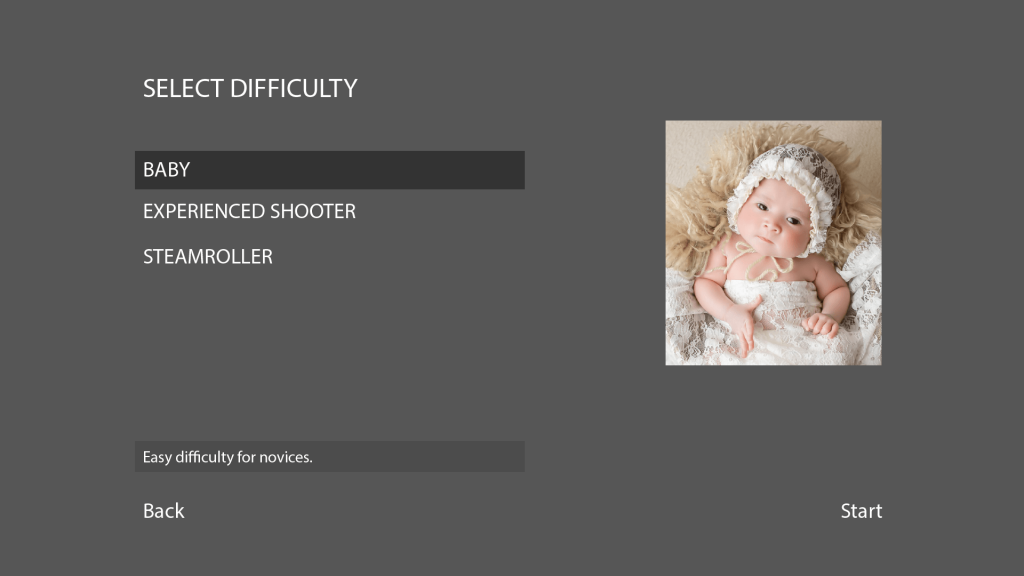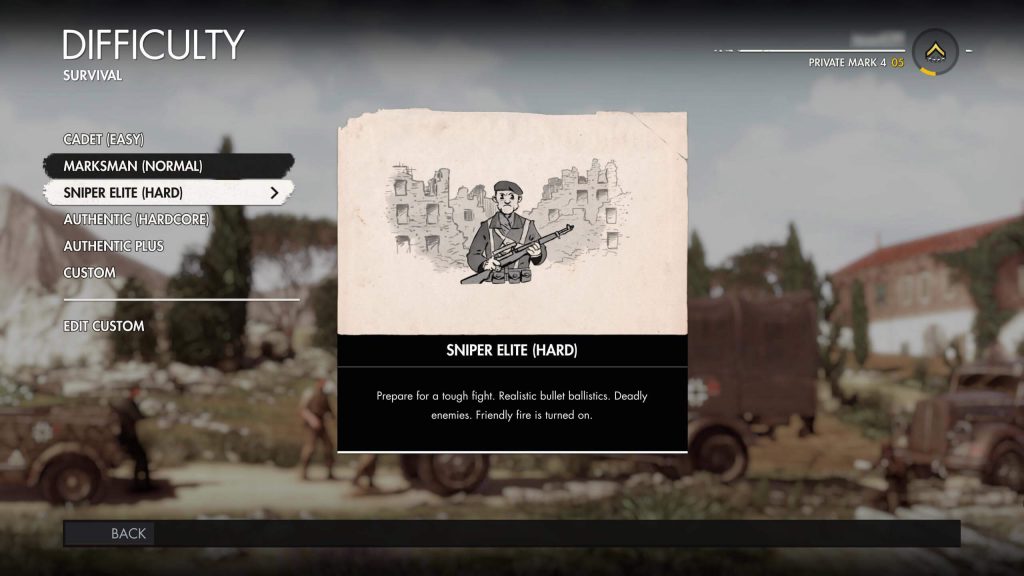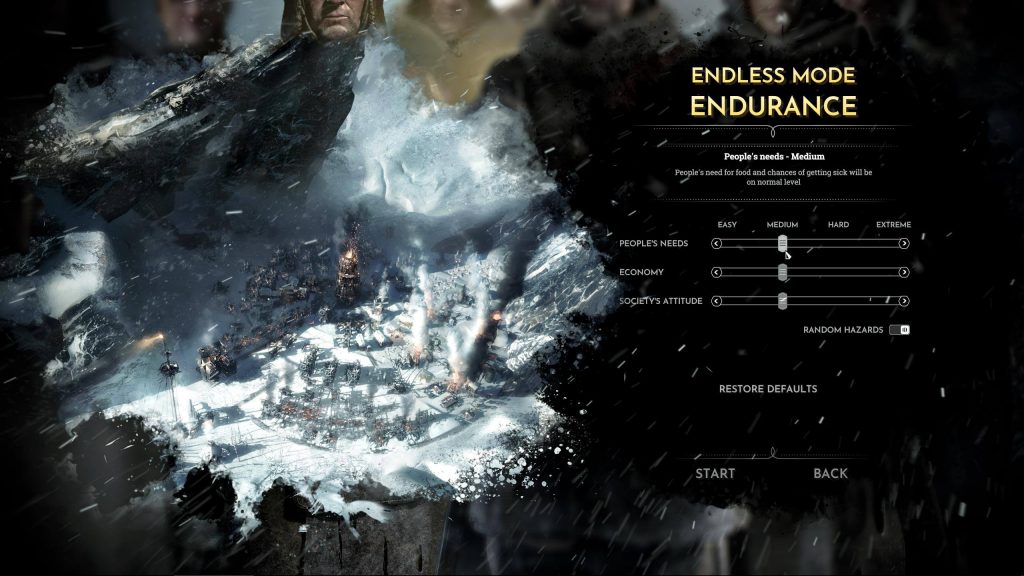Allow Players to Change the Game Difficulty
On this page
Players define their desired experience either before or during gameplay. Should it center around a relaxed exploration of the game’s narrative, or should it emphasize a more intense and demanding challenge? Perhaps a balanced experience that falls somewhere in between would be most suitable? Whether players are engaging in a short scenario (such as a deathmatch) or undertaking an extensive journey through a full story mode, they expect the challenge to feel fair. If your target audience is broad and encompasses a wide range of skill levels, you have two primary options:
Option 1: Offer a Selection of Profiles (Difficulties)
Allow players to customize their experience according to their skill level and the degree of challenge they wish to face.
For additional information on this option, refer to Offer Multiple Difficulties.
Option 2: Offer Only One Difficulty
Design the game with a single, unified level of challenge in mind.
For further details on this option, see Offer Only One Difficulty.
Offer Multiple Difficulties
To provide multiple well-balanced difficulty levels, begin by optimizing gameplay for one core difficulty that delivers a balanced experience for players with moderate familiarity with the genre.
Once the core gameplay is refined, and if your target audience includes casual players with limited experience, introduce at least one easier difficulty level. This version should offer a more forgiving experience in aspects such as required patience, problem-solving, determination, or concentration. These easier settings will also appeal to players who wish to focus primarily on the story rather than mastering complex gameplay mechanics.
If your target audience also includes experienced or “hardcore” players, it is advisable to include at least one difficulty tailored to their expectations. These players typically seek greater challenges or enhanced rewards.
When implementing multiple difficulty levels, avoid merely adjusting basic metrics such as health, damage, reaction times, or available resources. Modifying only these values may be perceived as unbalanced or uninspired. For instance, simply turning a standard enemy into a stronger version by increasing:
Health points.
Attack power.
Reaction speed.
may result in a dull experience, as the increased difficulty offers no new gameplay dynamics. Instead, consider introducing variety through more sophisticated changes, such as altering the strategies employed by AI opponents or using other techniques described in Make Your Game More or Less Challenging.
Below are examples of potential AI tactics for strategy games, illustrating how enemy behavior can vary by difficulty. The tactic names are illustrative and not industry standards:
Troublemaker: Periodically attacks the player with moderate-sized forces.
Defender: Avoids offensive actions and focuses on constructing a powerful defense system.
Thunder: Remains inactive for a prolonged period, then launches a massive assault in an attempt to eliminate the player in a single attack. If unsuccessful, it continues sending large forces to deplete and eventually break through the player’s defenses.
Flash: Launches immediate small-scale attacks from multiple directions and escalates with larger forces over time.
Help Players Choose the Most Appropriate Difficulty
If your game includes multiple difficulty options, it is crucial to assist players in selecting the most suitable one. Providing a clear and concise description of how gameplay mechanics differ between difficulty levels is highly beneficial. Common labels such as “easy,” “normal,” or “hard” are often too vague. What may be considered “normal” difficulty for one player could be experienced as “hard” by another.
Although using unconventional or creative names for difficulty settings may appear innovative, it is vital to accompany these names with detailed descriptions that explain how each level varies from the others. Without such explanations, players may struggle to make informed decisions.
Avoid naming difficulties in a way that may be perceived as demeaning. For instance, labeling the easiest mode with names or images that suggest it is intended for infants, elderly individuals, or those perceived as less competent may be offensive to some players.
A first-person shooter difficulty labeled “Baby” accompanied by an image of an infant implies that this mode is only for those who are incapable of playing well.
In Sniper Elite 4, each difficulty level is accompanied by a suitable image and an informative description that outlines how gameplay will differ.
Credit: Rebellion Developments. Screenshot captured by the author.
Selecting the correct difficulty level is rarely straightforward, particularly for players unfamiliar with the game. Even the most accurate descriptions cannot guarantee a perfect match. Ultimately, players must select a difficulty and play the game for a while to determine if it aligns with their preferences and abilities.
Allow Players to Change the Difficulty During Gameplay
It is possible that players select a difficulty level only to find that the gameplay does not offer the desired level of challenge—either being too easy or excessively difficult. Regardless of their prior gaming experience, players may wish to adjust the difficulty after spending some time in the game, without losing their progress or the time they have already invested. Allowing difficulty changes during gameplay is particularly beneficial in games that feature a continuous experience, such as narrative-driven adventures.
Allow Players to Create a Customized Difficulty
You may offer players the option to fine-tune their chosen difficulty level before gameplay commences, and ideally, also during gameplay. This can be achieved by exposing certain parameters, allowing players to adjust them according to their preferences. Such customization enables a more personalized gameplay experience.
In Frostpunk, players can customize various settings in the Endless mode: Endurance.
Credit: 11 bit studios S.A.. Screenshot captured by the author.
Ensure that the parameters exposed for customization do not compromise the overall experience, meaning there should be no possibility of creating a combination of settings that would break the game. Exercise caution when exposing any parameter that has been meticulously fine-tuned to work harmoniously with others. Below are examples of options that can be made available for player customization:
Assist Modes
Customizing assist modes should directly impact the game’s difficulty. These modes may include, for example:
Character Assist Modes
Aiming Assist: The player’s reticle automatically snaps to the enemy.
Stability Control: The player character automatically maintains balance while walking along very narrow elevated paths.
Vehicle Assist Modes
Aiming Assist: The player’s reticle automatically snaps to the enemy.
Braking Assist: The player’s vehicle automatically applies the appropriate amount of braking force.
Shifting Assist: The player’s vehicle automatically manages gear shifting.
Stability Control: The player’s vehicle automatically adjusts the braking force applied to each wheel to prevent the vehicle from spinning out.
Steering Assist: The player’s vehicle automatically prevents the player from driving off the track.
Traction Control: The player’s vehicle automatically prevents excessive wheelspin.
Players should be allowed to activate individual assist modes and adjust their strength, if applicable, to achieve the desired behavior for their playable character or vehicle. Activating or strengthening assist modes should result in a decrease in game difficulty. If your game offers multiple difficulty options, allow players to enable or disable assist modes within any chosen difficulty setting.
Game Speed
Adjusting game speed can be particularly helpful for single-player or cooperative gameplay in strategy games, where players may wish to alter the speed during gameplay:
By selecting a desired speed through a menu or HUD option.
By pressing hardware buttons on their input device.
Game speed should be expressed as a speed factor or percentage. Increasing the game speed should correspondingly increase the game’s difficulty. For example:
Game speed
Factor
Percentage
Slow
0.7
70%
Normal
1.0
100%
Fast
1.3
130%
Given Damage
This setting would allow players to adjust the amount of damage they inflict, for instance, when using ranged or melee attacks.
Increasing the given damage should reduce the difficulty of the game. This setting should be expressed as a factor or percentage reduction. For example:
Given damage
Factor
Percentage
Low
0.7
70%
Normal
1.0
100%
Fast
1.3
130%
Infinite Resources
Players may be given the option to enable or disable access to infinite resources such as:
Energy.
Health, granting the player character or vehicle immortality or indestructibility, respectively.
In-game currency.
Stamina.
Enabling any of these settings should decrease the difficulty of the game.
Instant Elimination
Allow players to enable or disable the ability for the player character to instantly eliminate any threat with a single hit. Enabling this setting should enhance the overall accessibility of the game.
Recommended Path
This setting can allow players to enable or disable the display of a recommended path to follow in order to reach a desired destination. Such a path can be, for example:
The fastest route.
The safest route.
The shortest route.
Enabling this setting should enhance the accessibility of the game.
Recovery Speed
This setting would allow players to increase or decrease the recovery speed of elements such as:
Energy.
Health.
Stamina.
Increasing this setting should make the game more accessible. Express this adjustment as a factor or percentage. For example:
Recovery speed
Factor
Percentage
Slow
0.7
70%
Normal
1.0
100%
Fast
1.3
130%
Resistance to Damage
This setting would allow players to increase or decrease the amount of damage they receive from falls, hits, and similar events. Increasing this setting should enhance the accessibility of the game. Express this adjustment as a reduction factor or percentage. For example:
Resistance to damage
Factor
Percentage
Low
0.7
70%
Normal
1.0
100%
High
1.3
130%
Time Manipulation
Allow players to manipulate in-game time by fast-forwarding or rewinding events.
Fast-forwarding can help reduce the waiting period for certain events or conditions within the game world.
In Tacoma, players are able to rewind, pause, and fast-forward through past events such as recordings, which assists in uncovering clues necessary for progressing through the story.
Credit: The Fullbright Company. Footage captured by the author.
Rewinding can also be useful when players need to correct mistakes by returning to a previous point in time. Enabling rewinding should improve the accessibility of the game.
Additionally, you may allow players to define the number of time manipulations permitted during a single match, race, or event. Increasing this number should make the game more accessible.
Offer Only One difficulty
While offering multiple difficulty settings provides players with the flexibility to customize their gameplay experience, there is an alternative approach. As mentioned at the beginning of this guideline, optional objectives—set either by the game or the players themselves—can serve to adjust the level of challenge.
For instance, if you design your game primarily for newcomers and beginners, you would set the base difficulty low enough for these players to face relatively simple challenges. Players of any skill level could then increase the difficulty by pursuing optional objectives provided by the game or by setting their own personal goals. In this way, players can instantly adjust the challenge without needing to worry about whether the core gameplay objectives are too difficult to accomplish.
Alternatively, if your game is designed for more hardcore players, optional objectives could be used to make progress easier, thereby improving accessibility for less experienced players. Optional objectives can also enhance the replay value of your game.
By including only one difficulty setting, players are relieved from the burden of selecting the correct difficulty level at the start or, worse, needing to restart the entire game to adjust it. It is important to recognize that while some players are motivated purely by a sense of achievement in completing optional objectives, others require tangible rewards. Design your optional objectives with both types of players in mind, ensuring that meaningful rewards are available for players who either cannot or prefer not to set their own additional challenges but still desire varied levels of difficulty.
Consider an example of an imaginary action game. This game would not offer any selectable difficulty levels, and all players would face highly challenging opponents. However, whenever players confront an enemy, they would have options. They could choose to use ranged weapons to maintain a safe distance from enemies, thus making combat easier, or they could opt for melee weapons, which would make battles far more intense and unforgiving, but also more exciting and satisfying.
Therefore, players seeking rapid progress through the game could rely on ranged weapons for an easier experience, while those seeking greater challenge could engage in melee combat for a more demanding yet rewarding gameplay experience.



